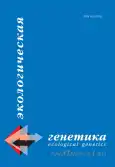Инфицированность эндосимбиотической бактерией Wolbachia видов блох (Siphonaptera: Insecta) Свердловской области и Хабаровского края
- Авторы: Илинский Ю.Ю.1, Юдина М.А.2, Калмыкова Е.А.2, Быков Р.А.1, Высочина Н.П.3, Винарская Н.П.4, Захаров И.К.1
-
Учреждения:
- Институт цитологии и генетики СО РАН
- Новосибирский государственный университет
- Хабаровская противочумная станция Роспотребнадзора
- Омский НИИ природно-очаговых инфекций
- Выпуск: Том 11, № 1 (2013)
- Страницы: 32-35
- Раздел: Статьи
- URL: https://journals.rcsi.science/ecolgenet/article/view/2392
- DOI: https://doi.org/10.17816/ecogen11132-35
- ID: 2392
Цитировать
Полный текст
Аннотация
Ключевые слова
Полный текст
Открыть статью на сайте журналаОб авторах
Юрий Юрьевич Илинский
Институт цитологии и генетики СО РАН
Email: paulee@bionet.nsc.ru
н. с., к. б. н. Лаборатория генетики популяций, Кафедра цитологии и генетики Новосибирского государственного университета
Мария Александровна Юдина
Новосибирский государственный университет
Email: maryjudina@gmail.com
студентка, кафедра цитологии и генетики
Екатерина Алексеевна Калмыкова
Новосибирский государственный университет
Email: ekkalm@yandex.ru
студентка, кафедра цитологии и генетики
Роман Андреевич Быков
Институт цитологии и генетики СО РАН
Email: bikovra@gmail.com
аспирант, лаборатория генетики популяций
Нэля Павловна Высочина
Хабаровская противочумная станция Роспотребнадзора
Email: neljavis@mail.ru
зав. лаб. (без степени), зоолого-паразитологическая лаб-рия
Наталья Петровна Винарская
Омский НИИ природно-очаговых инфекций
Email: vinarskayan@inbox.ru
к. б. н., с. н. с. Лаборатория арбовирусных инфекций
Илья Кузьмич Захаров
Институт цитологии и генетики СО РАН
Email: zakharov@bionet.nsc.ru
д. б. н., профессор, заведующий. Лаборатория генетики популяций
Список литературы
- Медведев С. Г., 1990. Классификация блох и проблемы ее обоснования // Успехи медицинской энтомологии и акарологии в СССР. С. 20–22.
- Медведев С. Г., 1998. Классификация отряда блох (Siphonaptera) и ее теоретические предпосылки //Энтомологическое обозрение. T. 77. C. 916–934.
- Медведев С. Г., 1994. Морфологические основы классификации отряда блох (Siphonaptera): Автореф. дис... докт. биол. наук. СПб, 50 c.
- Медведев С. Г., 2009. Систематика и географическое распространение и пути эволюции блох // Труды зоологического института РАН. Т. 313. C. 273–282.
- Росс Г., Росс Ч., Росс Д., 1985. Энтомология. М.: Мир. 576 с.
- Baldo L., Dunning Hotopp J. C., Jolley K. A., et al., 2006. Multilocus sequence typing system for the endosymbiont Wolbachia pipientis // Applied Environmental Microbiology. Vol. 72. P. 7098–7110.
- Dittmar K., Whiting M. F., 2004. New Wolbachia endosymbionts from nearctic and neotropical fleas (Siphonaptera) // J. Parasitol. Vol. 90. P. 953–957.
- Fischer P., Schmetz C., Bandi C. et al., 2002. Tunga penetrans: molecular identification of Wolbachia endobacteria and their recognition by antibodies against proteins of endobacteria from filarial parasites // Experimental Parasitology. Vol. 102. P. 201–211.
- Gorham C. H., Fang Q. Q., Durden L. A., 2003. Wolbachia endosymbionts in fleas (Siphonaptera) // J. Parasitol. Vol. 89. P. 283–289.
- Hilgenboecker K., Hammerstein P., Schlattmann P. et al., 2008. How many species are infected with Wolbachia? — A statistical analysis of current data //FEMS Microbiol. Lett. Vol. 281. P. 215–220.
- Jeyaprakash A., Hoy M. A., 2000. Long PCR improves Wolbachia DNA amplification: wsp sequences found in 76 % of sixty-three arthropod species // Insect Molecular Biology. Vol. 9, N 4. P. 393–405.
- Luchetti A., Mantovani B., Fioravanti M. L., Trentini M., 2004. Wolbachia infection in the newly described Ecuadorian sand flea, Tunga trimamillata // Exp. Parasitol. Vol. 108. P. 18–23.
- Luchetti A., Mantovani B., Trentini M., 2005. Wolbachia superinfection in an Ecuadorian sample of the sand-flea Tunga penetrans (Preliminary note) // Bull. Ins. Vol. 58. P. 93–94.
- Pampiglione S, Fioravanti M. L., Gustinelli A. et al., 2009. Sand flea (Tunga spp.) infections in humans and domestic animals: state of the art // Medical and Veterinary Entomology. Vol. 23. P. 172–186.
- Rolain J-M., Franc M., Davoust B., Raoult D., 2003. Molecular detection of Bartonella quintana, B. koehlerae, B. henselae, B. clarridgeiae, Rickettsia felis and Wolbachia pipientis in cat fleas, France // Emerging Infectious Diseases. Vol. 9. P. 338–342.
- Ros V. I. D., Fleming V. M., 2009. How diverse is the Genus Wolbachia? Multiple-gene sequencing reveals a putatively new Wolbachia supergroup recovered from spider mite (Acari: Tetranychidae) // Applied and Environment Microbiology. Vol. 7. P. 1036–43.
- Werren J. H., 1997. Biology of Wolbachia // Annual Review of Entomology. Vol. 42. P. 587–609.
- Whiting M. F., Whiting A. S., Hastriter M. W. et al., 2008. A molecular phylogeny of fleas (Insecta: Siphonaptera) and host association // Cladistics. Vol. 24. P. 677–707.
- Zag P., Hammerstein P., 2012. Still a host of hosts for Wolbachia: analysis of recent data suggests that 40% of terrestrial arthropod species are infected // PloS ONE. Vol. 7. I. 6. e38544.
Дополнительные файлы






